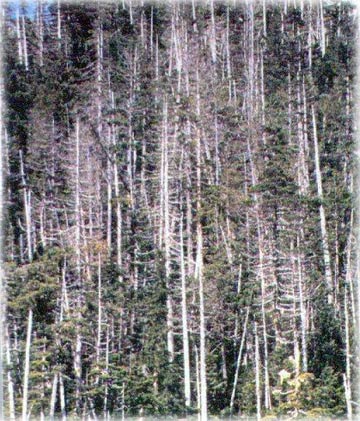
Yellow-cedar are dying in Alaska: Scientists now know why
February 01, 2012
“The cause of tree death, called yellow-cedar decline, is now known to be a form of root freezing that occurs during cold weather in late winter and early spring, but only when snow is not present on the ground,” explains Pacific Northwest Research Station scientist Paul Hennon, co-lead of a synthesis paper recently published in the February issue of the journal BioScience. “When present, snow protects the fine, shallow roots from extreme soil temperatures. The shallow rooting of yellow-cedar, early spring growth, and its unique vulnerability to freezing injury also contribute to this problem.” Yellow-cedar decline affects about 60 to 70 percent of trees in forests covering 600,000 acres in Alaska and British Columbia. The paper, “Shifting Climate, Altered Niche, and a Dynamic Conservation Strategy for Yellow-Cedar in the North Pacific Coastal Rainforest,” summarizes 30 years of research and offers a framework for a conservation strategy for yellow-cedar in Alaska. Some key findings include:
The yellow-cedar is a slow-growing tree; many are 700 to 1,200 years old. The tree has long been culturally significant to Native Alaskans who use it to make paddles, masks, dishes, and woven items. The wood is also very valuable commercially (for home and boat building) because of its straight grain, durability, and resistance to insects. Attention is now directed toward a solution to protect and manage yellow-cedar, as coastal Alaska is expected to experience less snow but a persistence of periodic cold weather events in the future. Scientists are working with partners in the Alaska Region of the Forest Service to use this new information as the framework for a comprehensive conservation strategy for yellow-cedar in Alaska in the context of a changing climate. “We also have ongoing projects with colleagues in the Tongass National Forest in Alaska on planting and thinning to favor yellow-cedar on suitable habitat,” adds co-lead author and station scientist Dave D’Amore, “especially on well-drained productive soils where most of the commercial forestry exits. Silvicultural techniques can be used to nudge the ecological niche of yellow-cedar, making it more competitive on these favorable sites.” Other coauthors of the synthesis are Paul Schaberg, U.S. Forest Service, Northern Research Station; Dustin Wittwer, U.S. Forest Service, Alaska Region; and Colin Shanley, The Nature Conservancy.
On the Web:
Source of News:
E-mail your news &
photos to editor@sitnews.us
|
|||
